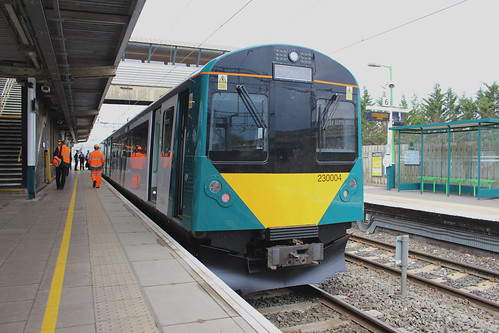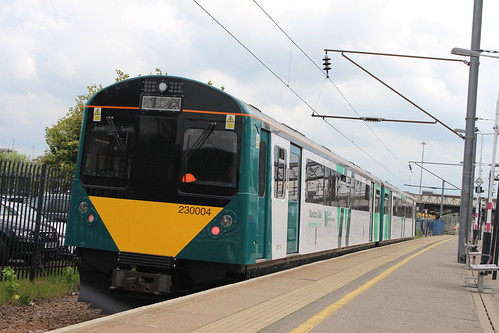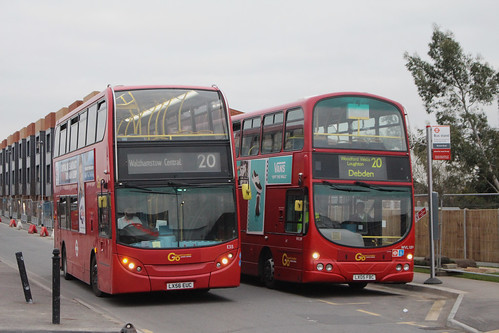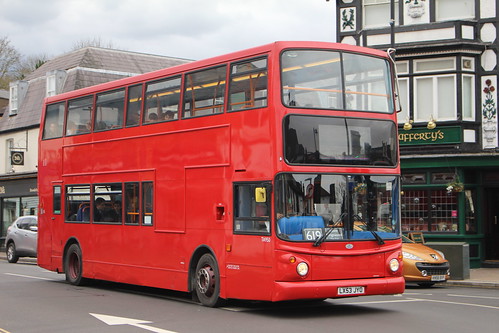
230004 on the second day of service at Bedford.
© Aubrey Morandarte
These "upcycled" trains have, instead of a pickup shoe to pick up electricity, there is a diesel motor which drives an electric source, which is used to power the motors which are pre-existing from the D78 Stock. The bodyshell, chassis, some parts of the seating, motors and bogies are all pre-existing from the D78, whilst the interior and other major things have been added or changed.

Spot the difference? Merely two years ago, the last D78 ran in passenger service on the Underground.
© Aubrey Morandarte
There had been some testing mishaps back in 2016, when it was mooted that they would be tested on the Coventry-Nuneaton line under former West Midlands franchise operator, London Midland (Govia). However, unfazed by the setbacks in 2016, the incoming new franchise operator, West Midlands Trains (Abellio-JR East-Mitsui) took three of the Vivarail units for the Bedford - Bletchley line. As the Vivarail prototype is 230001, and the battery EMU is 230002, these took the TOPS numbers of 230003-5.
This video shows a ride between Bow Brickhill and Woburn Sands. Clearly audible are the diesel engine undertones with the distinct pre-existing D Stock motors. The ride on the trains are the same as with the D Stock, as the bogies are the same as the ones fitted to the D78s since the late 1990s/early 2000s (fitted by Adtranz). Seating is fairly comfortable considering the type of seats chosen, although the opinion may be in part due to the author's frequency of using trains with the same type of seating. The door closing can be clearly heard, and closes with greater force than when under LU ownership.

230004 turns around at Bletchley for a trip to Bedford Midland
© Aubrey Morandarte
The front of the train has been slightly modified to meet modern crash worthiness standards. New LED lights replace the under-body lighting seen on the D Stock. The emergency door at the front has been plated up, and a fully modernised cab has been installed.

Interior of one coach of 230004, Bedford
© Aubrey Morandarte
One coach has been refurbished extensively, with the centre doors being boarded up. The seats between the boarded up centre doors are of the "ironing board" high backed seats, with the longitudinal being refreshed seats from the 2005-2008 refurbishment with London Underground. All seats have new moquette, and padding. Handrails have been repainted, the LED displays have been replaced internally (but the housing has not been replaced).

Interior of the other coach of 230004, Bletchley
© Aubrey Morandarte
The second coach has the corridor-side part with the existing layout. The centre part has a similar layout until the second boarded up door, where a new accessible toilet has been installed. Yes, for the first time, one can legally go to the toilet on a D Stock.

Toilet and wheelchair space within train.
© Aubrey Morandarte
An extended wheelchair area is located next to the toilet, which is all near to the front set of doors, where four original seats are retained between the door and the cab. A mixed layout of seats overall, with a clean look. As a personal opinion, the refurbishment seems to be very neat, to the extent that some can think it was a completely new train.

Table seating next to a boarded up door, note the shorter windows.
© Aubrey Morandarte
The trains are fitted with plug socket and USB charging points underneath the transverse seating, with USB chargers between seats embedded at the bottom of the arm rests next to the longitudinal seating.

Detail of the longitudinal seating, original from the mid-2000s LU refurbishment.
© Aubrey Morandarte
One thing also changed from the original D Stock is the installation of a inter-car corridor, operated by pressing a button which unlocks the first door, with the second door opening using a handle from the corridor. This introduction of the corridor has made walking between carriages safer. Also seen on the photograph on the left is the exhaust from the underfloor diesel engine.
© Aubrey Morandarte
There are posters detailing both the train's history as well as notable connections and notable information of each place on the line.
© Aubrey Morandarte

A line diagram using the former advertising panels. Further detailing of each panel can be seen:
Bletchley-Bow Brickhill
Woburn Sands-Ridgemount
Lidlington-Stewartby
Kempston Hardwick-Bedford Midland

© Aubrey Morandarte
The Marston Vale trains have special branding, with a whiter version of the LNR livery. This photo also shows the side external displays for the destination, as well as the treatment for the former doors.

230004 leaving Bedford for the Marston Vale line.
© Aubrey Morandarte
Overall, these trains are a fair, refreshing low cost upgrade to the Class 150/153s that are usually on the route. Although the trains themselves are OLDER than the Sprinters that they replace, they are notably more efficient due to the electric motor driving the wheels, rather than the diesel transmission. This leads to an mpg which is lower than Pacer trains.
Vivarail have done an excellent job with the interior refurbishment, and the quietness of the engine does mean that the loudest sound is usually the motor noises, or the train announcements. The interior is more airy than their predecessors, with brighter lighting thanks to the LED interior lighting.
The main issue would possibly be the toilet sinks having too powerful water pressure at the taps, but otherwise are very good units. These are set to be the only DEMUs from Vivarail so far ordered, as the 230s for Transport for Wales will be diesel-electric hybrid trains.
Post, photos and video by Aubrey Morandarte
All rights reserved © WLTMTB 2019
© Aubrey Morandarte

A line diagram using the former advertising panels. Further detailing of each panel can be seen:
Bletchley-Bow Brickhill
Woburn Sands-Ridgemount
Lidlington-Stewartby
Kempston Hardwick-Bedford Midland

© Aubrey Morandarte
The Marston Vale trains have special branding, with a whiter version of the LNR livery. This photo also shows the side external displays for the destination, as well as the treatment for the former doors.

230004 leaving Bedford for the Marston Vale line.
© Aubrey Morandarte
Overall, these trains are a fair, refreshing low cost upgrade to the Class 150/153s that are usually on the route. Although the trains themselves are OLDER than the Sprinters that they replace, they are notably more efficient due to the electric motor driving the wheels, rather than the diesel transmission. This leads to an mpg which is lower than Pacer trains.
Vivarail have done an excellent job with the interior refurbishment, and the quietness of the engine does mean that the loudest sound is usually the motor noises, or the train announcements. The interior is more airy than their predecessors, with brighter lighting thanks to the LED interior lighting.
The main issue would possibly be the toilet sinks having too powerful water pressure at the taps, but otherwise are very good units. These are set to be the only DEMUs from Vivarail so far ordered, as the 230s for Transport for Wales will be diesel-electric hybrid trains.
Post, photos and video by Aubrey Morandarte
All rights reserved © WLTMTB 2019






























